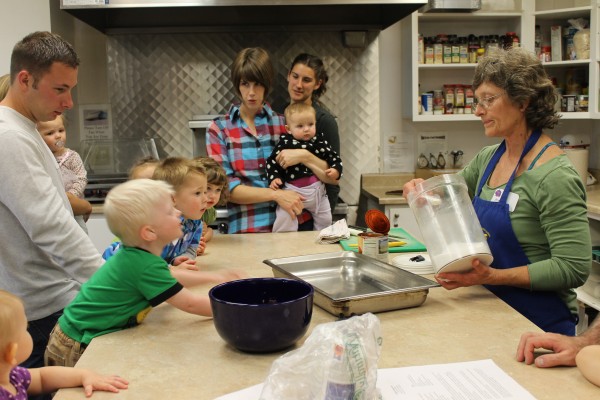Foodies at the Food Bank teaches children value of veggies
September 4, 2014

Nancy Tarnai
907-474-5042
9-4-2014
Four gorgeous heads of cabbage perched on a bare counter soon generated a busy scene as children and their parents stirred, measured, mixed and sampled cabbage creations Aug. 28 at the Fairbanks Community Food Bank kitchen.
Yes, spillage occurred, but that was OK, since children learn by doing.
One host held up cabbages and asked the youngsters what they were. It took a few tries, but someone at last got the right answer.
The children then delighted in making stuffed rolls, salad and lily pad pancakes with the cabbage fresh from the Basically Basil farm.
Taught by Cooperative Extension Service’s Marsha Munsell, the workshop showed families that cooking together can be fun. It was one in a series sponsored by the Children's Health Living program at the University of Alaska Fairbanks.
“We encourage you to try this at home,” Munsell told participants. Several of the parents said they routinely involve their children in food preparation.
Cabbage may seem an unusual choice for a kids’ cooking program.
"It depends," said Sarah Sherman, a CHL program research technician. "If you make it colorful and fun, it’s easier to like. You need to make it visual.”
At the August workshop, the children munched on raw cabbage as if it were candy. In a handout provided by CHL, cabbage is touted as an Alaska classic rich in nutrients, health benefits and delicious flavor. Offering iron, fiber, antioxidants, folate, and vitamins K, C and A, cabbage is also anti-inflammatory, high in fiber and low in calories.
Cabbage is now readily available at local farmers markets and school farm stands. One head produces an amazing amount of leaves to work with. When choosing green and red cabbage, pick tight, compact heads that feel heavy. They should look crisp and fresh with few loose leaves. Leafy varieties (Napa) should be green with stems that are firm.
Store whole heads in the crisper drawer. If uncut, they should keep for a couple of weeks. Leafy varieties should be used within a few days.
To preserve the heads, remove outer leaves, quarter the cabbage, keeping the core, and blanch by dropping the chunks in boiling water for three minutes. Remove immediately and let cool on ice, drain, dry and place in airtight bags. Freeze the bags. The cabbage can be used in stir fries and soups.
Even the youngest toddlers can help, according to the CHL brochure. Those under 2 years old can wash veggies and break or tear them. Two- to 3-year-olds can mix batters and stir sauces and pour ingredients into bowls. The 4- to 5-year-olds can cut soft fruits and veggies with a plastic knife, beat eggs with a whisk and measure ingredients. The 6- to 8-year-olds can chop and dice with supervision, grate cheese and crack eggs.
UAF Assistant Professor Andrea Bersamin, head of the CHL program, explained that the new cooking series is a partnership between her program, SNAP-Ed (a food stamp program) and the Food Bank to promote healthy eating and an active lifestyles among young children and their families.
"Families are eating more of their calories away from home than ever before because of busy schedules,” Bersamin said. “People who eat more of their calories away from home tend to have poorer diets and consume fewer vegetables and fruits. Conversely, there are many benefits to cooking at home, especially as a family.”
Cooking together is not only fun but can be done fairly quickly, resulting in delicious, healthy meals, Bersamin said. “We also want to promote local produce that is readily available and inexpensive," she said.
CHL is a U.S. Department of Agriculture-funded program designed to promote healthy eating for children ages 2 to 8.
“We want to learn how to make healthy choices easy choice for families,” Bersamin said.
Workshops are free for families with young children. Upcoming workshops will cover berries on Sept. 25 and carrots on Oct. 30. Both workshops will be held from 5 to 7 p.m. at the Food Bank, 725 26th Ave. Sign up in advance by calling 474-6458.


